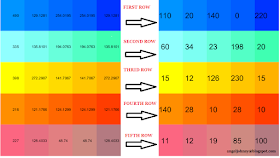Fast Fourier transformation on a 2D matrix can be performed using
the MATLAB built in function ‘fft2()’.
Fourier transform is one of the various mathematical
transformations known which is used to transform signals from time domain to
frequency domain.
The main advantage of this transformation is it makes life easier for many problems when we deal a signal in frequency domain rather than time domain.
The main advantage of this transformation is it makes life easier for many problems when we deal a signal in frequency domain rather than time domain.
Example:
%FOURIER TRANSFORM ON A MATRIX
A = zeros(5);
A ( : ) = 1:25;
display(A);
F_FFT = fft2(A);
display(F_FFT);
%INVERSE FOURIER TRANSFORM
I_FFT = ifft2(F_FFT);
display(abs(I_FFT));
NOTE on ABSOLUTE
VALUE:
When we use FFT2() or FFT(),the result we obtain in the
frequency domain is of complex data type.
i.e It contains both the real as well as the imaginary part.
Let A=10+5i
A is a complex number as it contains both real and imaginary
part.In this particular case ‘10’ is
the real part and ‘5’ is the imaginary
part.
abs(A) = 11.1803 is the absolute (also called modulus in few
books or notations) value of A which is nothing but the magnitude. It can be
arrived by using the below mentioned formula:
abs(A) = sqrt(real part^2+imaginary part^2).
= sqrt(10^2+5^2)
=
sqrt(125)
= 11.1803
(approx)
Let’s try to understand how the Fourier transform on 2
dimensional data works with a simple example.
This method will be helpful to understand the up sampling
and down sampling in both spatial and frequency domain.
2.
Perform 1 D Fast Fourier transform(FFT) on each
row
1D FFT on first row (Note that the absolute value is only displayed and not the actual imaginary number):
1D FFT on first row (Note that the absolute value is only displayed and not the actual imaginary number):
NOTE: The figure represents the 1 D FFT on each row and the result is the absolute value of the complex data obtained using FFT.
3.
Perform 1 D Fast Fourier transform on each
column.
On the matrix obtained from the previous step, compute 1D FFT column wise.
On the matrix obtained from the previous step, compute 1D FFT column wise.
4.
Display the results obtained.
Flow Chart for Fast Fourier Transform on 2D :
INVERSE FOURIER
TRANSFORM:
1.
Perform Inverse Fourier Transform on each column
2.
Perform IFFT on each row
3.
Display the original data
MATLAB CODE:
A=[110 20 140 0 220;
60 34 23 198 20;
15 12 126 230 15;
140 28 10 28 10;
11 12 19 85 100];
FFT_row = zeros(size(A));
FFT_col = zeros(size(A));
%Perform FFT on each row
for i=1:size(A,1)
FFT_row(i,:) = fft(A(i,:));
end
display(FFT_row);
%display(abs(FFT_row));
%Perform FFT on each column
for i=1:size(A,2)
FFT_col(:,i) = fft(FFT_row(:,i));
end
display(FFT_col);
%display(abs(FFT_col));
%INVERSE FOURIER TRANSFORM
IFFT_row = zeros(size(A));
IFFT_col = zeros(size(A));
%Perform Inverse Fourier
Transform on each column
for i=1:size(A,2)
IFFT_col(:,i) =
ifft(FFT_col(:,i));
end
%Perform IFFT on each row
for i=1:size(A,2)
IFFT_row(:,i) =
ifft(IFFT_col(:,i));
end
display(abs(A))
ALTERNATE METHOD FOR
INVERSE FOURIER TRANSFORM:
Instead of using
ifft2() or ifft(), we can also use the following method to obtain the original
data from the Fast Fourier transformed result :
1.
Obtain the conjugate of the Forward FFT
2.
Perform Forward fast Fourier transform
3.
Obtain the conjugate of the result from step 2.
4.
Divide it by the number of elements present in
the matrix
MATLAB CODE:
Conj_F = conj(F_FFT);
Conj_FFT = fft2(Conj_F);
IFFT_conj = conj(Conj_FFT)/numel(Conj_FFT)
display(abs(IFFT_conj));
Reference: Digital Image Processing by Rafael C.Gonzalez, fourth Chapter.







Thanks for the article. I have a question which is very basic.
ReplyDeleteWhat is the calculation method used while taking fft of each row/column? How the fft of first row [110 20 140 0 220] is taken as [490 129.1281 254.0195 254.0195 129.1281]